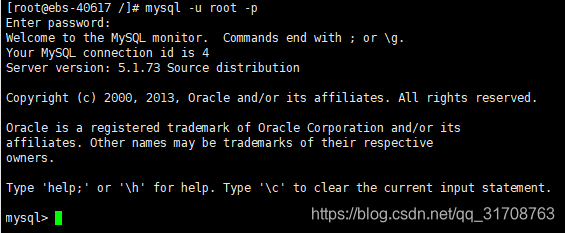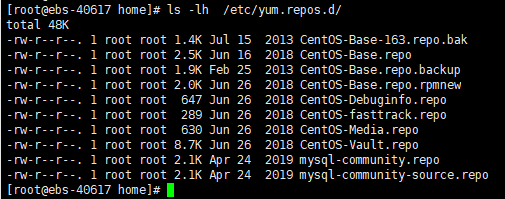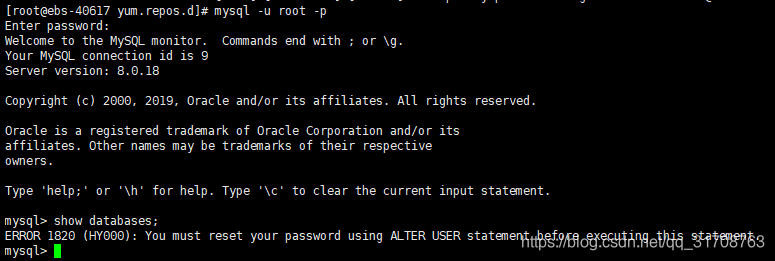centos6上使用yum方式安装MySQL
centos6上使用yum方式安装MySQL

JaneYork
发布于 2023-10-11 14:37:54
发布于 2023-10-11 14:37:54
系统:centos6
mysql:5.1.73 /8.0.18
一、直接yum默认源安装。
1.检查是否安装了MySQL。
rpm -qa | grep mysql
rpm -e mysql //普通删除模式,有时候会提示依赖于其他文件,无法删除。
# 强力删除模式,用该命令强力删除
rpm -e --nodeps mysql
rpm -e --nodeps mysql-libs-5.1.73-8.el6_8.x86_642.下载安装。
# 查看yum上可下载的MySQL
yum list | grep mysql
# 安装
yum install -y mysql-server mysql mysql-devel3.初始化及配置。
# 启动
service mysqld start
# 检查是否开机启动
chkconfig --list | grep mysqld
# 设置root密码
mysqladmin -u root password 'nishipogaizaima'
# 登录,输入刚才设置的密码
mysql -u root -p

# 修改字符编码
cp /usr/share/doc/mysql-server-5.1.73/my-large.cnf /etc/my.cnf
vim /etc/my.cnf
# 在[client]下增加default-character-set=utf8字段
# 在[mysqld]下增加default-character-set=uft8字段(起不来)
# 重启服务
service mysqld restart
#yum默认安装位置
# 数据库目录
/var/lib/mysql/
# 配置文件
/usr/share /mysql(mysql.server命令及配置文件)
# 相关命令
/usr/bin(mysqladmin mysqldump等命令)
# 启动脚本
/etc/rc.d/init.d/(启动脚本文件mysql的目录)# Example MySQL config file for large systems.
#
# This is for a large system with memory = 512M where the system runs mainly
# MySQL.
#
# MySQL programs look for option files in a set of
# locations which depend on the deployment platform.
# You can copy this option file to one of those
# locations. For information about these locations, see:
# http://dev.mysql.com/doc/mysql/en/option-files.html
#
# In this file, you can use all long options that a program supports.
# If you want to know which options a program supports, run the program
# with the "--help" option.
# The following options will be passed to all MySQL clients
[client]
#password = your_password
port = 3306
socket = /var/lib/mysql/mysql.sock
default-character-set=utf8
# Here follows entries for some specific programs
# The MySQL server
[mysqld]
port = 3306
socket = /var/lib/mysql/mysql.sock
skip-locking
key_buffer_size = 256M
max_allowed_packet = 1M
table_open_cache = 256
sort_buffer_size = 1M
read_buffer_size = 1M
read_rnd_buffer_size = 4M
myisam_sort_buffer_size = 64M
thread_cache_size = 8
query_cache_size= 16M
# Try number of CPU's*2 for thread_concurrency
thread_concurrency = 8
# Don't listen on a TCP/IP port at all. This can be a security enhancement,
# if all processes that need to connect to mysqld run on the same host.
# All interaction with mysqld must be made via Unix sockets or named pipes.
# Note that using this option without enabling named pipes on Windows
# (via the "enable-named-pipe" option) will render mysqld useless!
#
#skip-networking
# Replication Master Server (default)
# binary logging is required for replication
log-bin=mysql-bin
# binary logging format - mixed recommended
binlog_format=mixed
# required unique id between 1 and 2^32 - 1
# defaults to 1 if master-host is not set
# but will not function as a master if omitted
server-id = 1
# Replication Slave (comment out master section to use this)
#
# To configure this host as a replication slave, you can choose between
# two methods :
#
# 1) Use the CHANGE MASTER TO command (fully described in our manual) -
# the syntax is:
#
# CHANGE MASTER TO MASTER_HOST=<host>, MASTER_PORT=<port>,
# MASTER_USER=<user>, MASTER_PASSWORD=<password> ;
#
# where you replace <host>, <user>, <password> by quoted strings and
# <port> by the master's port number (3306 by default).
#
# Example:
#
# CHANGE MASTER TO MASTER_HOST='125.564.12.1', MASTER_PORT=3306,
# MASTER_USER='joe', MASTER_PASSWORD='secret';
#
# OR
#
# 2) Set the variables below. However, in case you choose this method, then
# start replication for the first time (even unsuccessfully, for example
# if you mistyped the password in master-password and the slave fails to
# connect), the slave will create a master.info file, and any later
# change in this file to the variables' values below will be ignored and
# overridden by the content of the master.info file, unless you shutdown
# the slave server, delete master.info and restart the slaver server.
# For that reason, you may want to leave the lines below untouched
# (commented) and instead use CHANGE MASTER TO (see above)
#
# required unique id between 2 and 2^32 - 1
# (and different from the master)
# defaults to 2 if master-host is set
# but will not function as a slave if omitted
#server-id = 2
#
# The replication master for this slave - required
#master-host = <hostname>
#
# The username the slave will use for authentication when connecting
# to the master - required
#master-user = <username>
#
# The password the slave will authenticate with when connecting to
# the master - required
#master-password = <password>
#
# The port the master is listening on.
# optional - defaults to 3306
#master-port = <port>
#
# binary logging - not required for slaves, but recommended
#log-bin=mysql-bin
# Uncomment the following if you are using InnoDB tables
#innodb_data_home_dir = /var/lib/mysql
#innodb_data_file_path = ibdata1:10M:autoextend
#innodb_log_group_home_dir = /var/lib/mysql
# You can set .._buffer_pool_size up to 50 - 80 %
# of RAM but beware of setting memory usage too high
#innodb_buffer_pool_size = 256M
#innodb_additional_mem_pool_size = 20M
# Set .._log_file_size to 25 % of buffer pool size
#innodb_log_file_size = 64M
#innodb_log_buffer_size = 8M
#innodb_flush_log_at_trx_commit = 1
#innodb_lock_wait_timeout = 50
[mysqldump]
quick
max_allowed_packet = 16M
[mysql]
no-auto-rehash
# Remove the next comment character if you are not familiar with SQL
#safe-updates
[myisamchk]
key_buffer_size = 128M
sort_buffer_size = 128M
read_buffer = 2M
write_buffer = 2M
[mysqlhotcopy]
interactive-timeout二、指定yum源安装。
仓库源都给你了,还想怎样?https://dev.mysql.com/downloads/repo/yum/
这里下载centOS6
cd /home/
wget https://dev.mysql.com/get/mysql80-community-release-el6-3.noarch.rpm
# 安装
yum -y localinstall mysql80-community-release-el6-3.noarch.rpm
# 或
rpm -Uvh mysql80-community-release-el6-3.noarch.rpm#安装成功后在/etc/yum.repos.d/下会多出几个mysql的yum源的配置
ls -lh /etc/yum.repos.d/
查看是否可用: yum repolist enabled | grep mysql

# 安装,网速慢,失败,可重新执行
yum -y install mysql-community-server
# 查看MySQL版本
mysql -V
# 启动,失败可重试
service mysqld start
# 重启
service mysqld restart

查看root默认密码:
cat /var/log/mysqld.log | grep root@localhost

修改密码:
mysql -u root -p
输入密码进入MySQL命令行,执行任何操作都提示你要修改密码:
ERROR 1820 (HY000): You must reset your password using ALTER USER statement before executing this statement.

set password=password('nishipogaizaima');
alter user 'root'@'localhost' password expire never;
flush privileges;下载慢,改为国内yum源:https://blog.csdn.net/qq_31708763/article/details/102999274
ls /etc/yum.repos.d/*.repo
以repo结尾的都是正在使用的yum源站MySQL8修改密码:
# 建议使用复杂密码,否则提示ERROR 1819 (HY000): Your password does not satisfy the current policy requirements
ALTER user 'root'@'localhost' IDENTIFIED BY 'Woshipogaizai123$$';
# 刷新权限
flush privileges;
# 退出
exit;额外:
Linux上MySQL卸载:https://blog.csdn.net/qq_31708763/article/details/86485398
本文参与 腾讯云自媒体同步曝光计划,分享自作者个人站点/博客。
原始发表:2023-10-11,如有侵权请联系 cloudcommunity@tencent.com 删除
评论
登录后参与评论
推荐阅读

